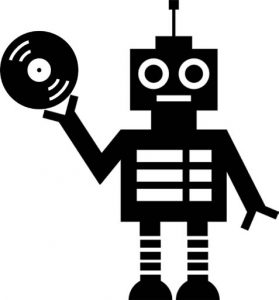I, CHATBOT

You literary types are probably thinking I got the inspiration for this month’s column from Isaac Asimov’s 1950 book I, Robot, which is a collection of short stories tied together with the theme of interactions between humans and robots. If that’s what you’re thinking, you’re wrong.
The inspiration for this column actually came from a 1977 album by The Alan Parsons Project, a British post-punk progressive rock band in the vein of early Yes, Emerson Lake & Palmer, Jethro Tull and so on. Like many bands of the late 1970s, The Alan Parson Project consisted of a couple of guys and a bunch of sidemen. Think Donald Fagin and Walter Becker of Steely Dan, or Don Henley and Glen Frey of the Eagles. Same setup. Alan’s partner was Scottish musician Eric Woolfson. I have no idea why the band wasn’t called The Eric Woolfson Project. We’ll probably never know since Woolfson passed away in 2009.
 The 1977 album in question, which I discovered when it was reissued in digital format in 2007, is called, “I Robot.” Note that they cleverly left out the comma between “I” and “Robot” in the album’s title so as to avoid any legal wrangling. While I’m not really a fan of prog-rock, this album lodged itself in my memory for a couple of reasons. First was a song called, “I Wouldn’t Want to Be Like You.” It was the first single released from the album and featured a catchy, driving, rhythmic back beat that was almost guaranteed to plant itself in your head in ear-worm fashion. That song still has life today, almost 40 years after its release.
The 1977 album in question, which I discovered when it was reissued in digital format in 2007, is called, “I Robot.” Note that they cleverly left out the comma between “I” and “Robot” in the album’s title so as to avoid any legal wrangling. While I’m not really a fan of prog-rock, this album lodged itself in my memory for a couple of reasons. First was a song called, “I Wouldn’t Want to Be Like You.” It was the first single released from the album and featured a catchy, driving, rhythmic back beat that was almost guaranteed to plant itself in your head in ear-worm fashion. That song still has life today, almost 40 years after its release.
“As with all innovation since the industrial revolution, machines are freeing us from tedious tasks, such as answering account balance questions a hundred times a day.”
The second reason “I Robot” remains lodged in my brain is the first cut of the album, a song also called “I Robot.” It is a six-minute instrumental, heavy on the Rick Wakeman-style digital synthesizer and driven by a rhythm that is dance-ready. It has been used as the basis for a dozen or more videos, many still available on YouTube and some made in just the last couple of years.
Robots aren’t the hot topic today that they were 40 years ago, although we’re still talking about robotics in the contact center. Of greater interest, especially in customer service, is the emergence of the chatbot. Chatbots are essentially applications that conduct text conversations with another person or device, simulating the way a human would behave as a conversational partner. In the customer service world, chatbots are being developed to provide text-based customer support and assistance in much the way interactive voice response (IVR) provides voice-based customer support. In fact, some use the term interactive text response (ITR) to describe text-based customer service.
Imagine a customer service application on a mobile device that allows you, as the customer, to make an inquiry using natural language and get straight to the information you want. Rather than having to go through an extensive IVR menu to get to the information, you “converse” with an automated agent, or chatbot, in the manner you would converse with a live agent.
To better understand chatbots in the contact center, I turned to Tobias Goebel, Director of Emerging Technologies at Aspect. If that name sounds familiar it’s because you’ve read it here before (see “Trading Places: Another Aspect of Innovation,” Contact Center Pipeline, January 2016). And I still wouldn’t mind trading for a while.
When it comes to chatbots for customer service, Aspect is pushing the envelope, and pushing it hard. So what is the state- of-the-art? According to Goebel, “Everything in customer self-service essentially starts with a question. For example, ‘Where is my order?’ or ‘What is the status of my claim?’ Chatbots are a perfect fit and very capable when the question is straightforward and the domain is limited, as it is in customer service. However, too much science fiction and vendor hype alike are making people believe that there is a ‘breakthrough’ in articifial intelligence (AI) imminent. People fail to understand that there is no one common AI system that mankind is working on. It’s just not how it works. Chatbots being developed now are optimized for a limited set of questions, and that’s OK as long as the contact center, with its trained human agents, can—and must—always be ready to jump in when the chatbot reaches its limits.”
In March of this year, the news was full of stories about Microsoft’s chatbot called Tay. Tay is an acronym for “thinking about you” and was programmed to mimic the language patterns of a 19-year-old American girl by learning, in an unsupervised fashion, from the users it interacted with.

Tay was initially released on Twitter and had the ability to respond to tweets from other users. Unfortunately, Microsoft was not able to program Tay with an understanding of inappropriate behavior and Tay was soon responding in kind to the offensive behavior of others. Within hours, Tay was responding to tweets with racially or sexually charged messages that I can’t repeat in this family magazine. Microsoft quickly took Tay offline and she hasn’t been heard from since.
Rather than pursuing a machine-learning approach for their chatbots, Aspect is enabling theirs with rules-based natural language understanding (NLU) software that is based on linguistics. Aspect’s Goebel explained, “In customer service, you cannot afford to have a black box that provides answers based on what it has learned automatically, yet that is what machine-learning algorithms essentially are—black boxes that do not allow the businesses to go in and surgically tweak how a user question should be interpreted. Also, we don’t always have the huge amounts of test phrases required to train a system that uses machine learning techniques alone. However, we have seen success with a semantics-based approach that is first based on intuition and introspection.”
One of Aspect’s first chatbot releases is Mila, a chatbot that functions as a contact center agent’s personal assistant. Aspect Mila lets agents use conversational chat to accomplish basic workforce optimization tasks such as schedule requests, time off requests, etc. AS ILLUSTRATED IN THE SCREEN SHOT, Mila chats with the agent in much the same way a supervisor would. Of course, that begs the question, will chatbots put supervisors and others in the contact center out of work?
Not according to Aspect’s Goebel. “The history of mankind has shown that technological advances can indeed change the work landscape. As with all innovation since the industrial revolution, machines are freeing us from tedious tasks, such as answering account balance quest ions a hundred times a day. Chatbots will answer simple questions faster and more accurately than humans, but human agents will forever be needed to help customers with complex businesses processes, to resolve complaints, and to reduce customer frustration when there is a problem by working on the emotional level and applying what only humans have—the human touch.”
Isaac Asimov’s book, and to an extent the “I Robot” album, are both stories about the expected rise of the thinking machine and the decline of man. When it comes to the contact center, “I, Chatbot” might be more appropriately about how chatbots are impacting the customer service profession for the betterment of both the worker and the customer.
Paul Stockford is Chief Analyst at Saddletree Research, which specializes in contact centers & customer service.
– Reprinted with permission from Contact Center Pipeline, http://www.contactcenterpipeline.com




